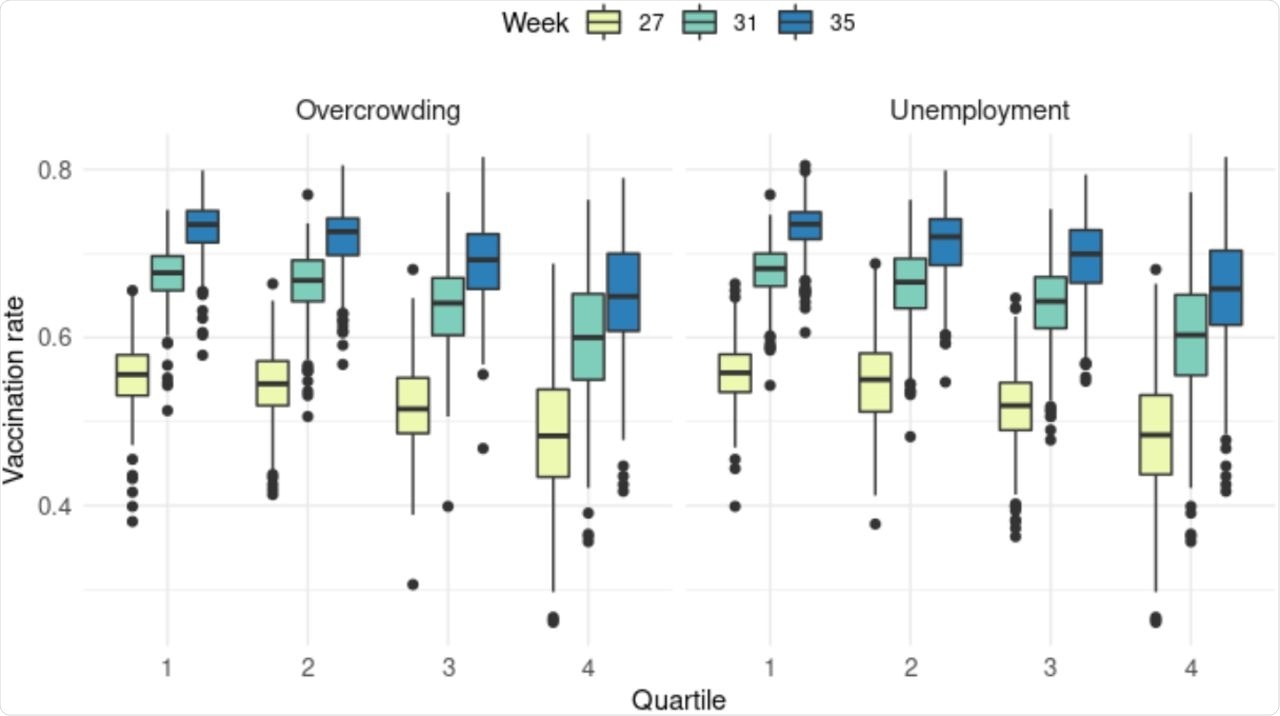In a recent study published on the medRxiv* preprint server, researchers determined factors influencing local heterogeneities in coronavirus disease 2019 (COVID-19) vaccination rates and the influence of the French sanitary pass on those heterogeneities using extensive nationwide data from France.

Study: The French domestic "sanitary pass" did not solve Covid-19 vaccination inequities in France. Image Credit: rarrarorro / Shutterstock.com

 This news article was a review of a preliminary scientific report that had not undergone peer-review at the time of publication. Since its initial publication, the scientific report has now been peer reviewed and accepted for publication in a Scientific Journal. Links to the preliminary and peer-reviewed reports are available in the Sources section at the bottom of this article. View Sources
This news article was a review of a preliminary scientific report that had not undergone peer-review at the time of publication. Since its initial publication, the scientific report has now been peer reviewed and accepted for publication in a Scientific Journal. Links to the preliminary and peer-reviewed reports are available in the Sources section at the bottom of this article. View Sources
Background
Although France has a demonstrated history of unwillingness towards vaccination that was confirmed during the COVID-19 pandemic, the acceptance of COVID-19 vaccination in France gradually rose throughout 2021.
Social and territorial inequalities are known to influence people's attitudes towards vaccination. For example, according to surveys conducted in 2020, vaccination rates in France are influenced by interviewees' level of education, income, and confidence in authorities.
To improve COVID-19 vaccination rates, France President Macron announced the implementation of a domestic sanitary pass (le passe sanitaire) on July 12, 2021, which was entirely implemented by August 9, 2021. The health pass was required in most public venues, such as outdoor and indoor dining areas and medical establishments. However, to date, the detailed information on the impact of the French sanitary pass on vaccination inequalities has not been fully assessed.
About the study
In the present study, the association between socioeconomic and geographic factors, COVID-19 vaccination, and health pass implementation in France was determined using comprehensive nationwide data.
The vaccination, socioeconomic, and geographic indicators data were collected from the French State Health Insurance Service (Assurance Maladie) public datasets. The Assurance Maladie provides public datasets of in-depth weekly COVID-19 first-dose vaccination data at the district scale across the country and at the suburban scale for the Marseille, Paris, and Lyon metropolitan areas.
The study included data of 63,601,670 individuals from 1,552 mainland French districts. These districts were associated with the five geographic and 176 socioeconomic indicators obtained from the same public datasets.
The relationship between being a district in the lowest quartile of first-dose vaccination rate and above the median value of each indicator was determined. Subsequently, the socioeconomic and geographic indicators odds ratio (OR) and their 95% confidence interval (CI) were determined on three timestamps that accounted for the before and after effects of health pass implementation.
The vaccination rates for the two socioeconomic and geographic indicators with the highest OR on the same dates were calculated. The analyses were conducted using R (v4.0.3) software.
Study findings
Both the income rate from unemployment benefits and the proportion of overcrowded households were found to be the most associated with local vaccination rates. To this end, the OR of unemployment and overcrowding at weeks 27, 31, and 37 were 12.6, 13.3, 11.9, and 11.6, 12, 15.7, with a 95% CI of [8.7; 18.9], [9.1; 20.0], and [8.2; 17.6], respectively.
The differences in percentile points-based vaccination rates between the first and fourth quartiles of unemployment and overcrowding indicators remained similar across the weeks. At weeks 27, 31, and 35, the difference in vaccination rate of unemployment was 7.6, 8, and 7.9 with a 95% CI of [6.6; 8.7], [7.0; 9.0], and [6.9; 8.9], respectively. The difference in vaccination rate of overcrowding at weeks 27, 31, and 35 were 6.9, 7.6, and 8.2 with a 95% CI of [5.7; 8.1], [6.6; 8.8], and [7.2; 9.1], respectively.
 Local vaccination rates depending on the quartile of the two main indicators (Overcrowding rate, left and Unemployment rate, right) and over time (weeks 27, 31, 35, with increasingly darker shading)
Local vaccination rates depending on the quartile of the two main indicators (Overcrowding rate, left and Unemployment rate, right) and over time (weeks 27, 31, 35, with increasingly darker shading)
Conclusions
The study results demonstrate that many deprived areas in France had more than ten times the likelihood of being among districts with the lowest vaccination rates. Low vaccination rates in France were associated with economically poor populations, thus indicating that the health pass did not resolve vaccination inequalities.
Districts with a large fraction of overcrowded housing or unemployment benefits constituting a large share of local income were strong determinants for low vaccination rates.
Previous studies have shown that most deprived areas had disproportional COVID-19 infection and hospitalization rates throughout the pandemic. The present study provides robust evidence for the strong impact of social inequalities on COVID-19 management.
Economically backward districts were the least vaccinated and at risk, despite implementing the domestic sanitary pass. Taken together, the current study underscores the pressing need for establishing new vaccination guidelines that address social inequalities.

 This news article was a review of a preliminary scientific report that had not undergone peer-review at the time of publication. Since its initial publication, the scientific report has now been peer reviewed and accepted for publication in a Scientific Journal. Links to the preliminary and peer-reviewed reports are available in the Sources section at the bottom of this article. View Sources
This news article was a review of a preliminary scientific report that had not undergone peer-review at the time of publication. Since its initial publication, the scientific report has now been peer reviewed and accepted for publication in a Scientific Journal. Links to the preliminary and peer-reviewed reports are available in the Sources section at the bottom of this article. View Sources
Journal references:
- Preliminary scientific report.
Debarre, F., Lecoeur, E., Guimier, L., et al. (2022). The French domestic "sanitary pass" did not solve Covid-19 vaccination inequities in France. medRxiv. doi:10.1101/2022.01.03.22268676. https://www.medrxiv.org/content/10.1101/2022.01.03.22268676v1.
- Peer reviewed and published scientific report.
Débarre, Florence, Emmanuel Lecoeur, Lucie Guimier, Marie Jauffret-Roustide, and Anne-Sophie Jannot. 2022. “French Covid-19 Vaccination Policy Did Not Solve Vaccination Inequities: A Nationwide Study on 64.5 Million People.” European Journal of Public Health 32 (5): 825–30. https://doi.org/10.1093/eurpub/ckac125. https://academic.oup.com/eurpub/article/32/5/825/6697909.
Article Revisions
- May 10 2023 - The preprint preliminary research paper that this article was based upon was accepted for publication in a peer-reviewed Scientific Journal. This article was edited accordingly to include a link to the final peer-reviewed paper, now shown in the sources section.